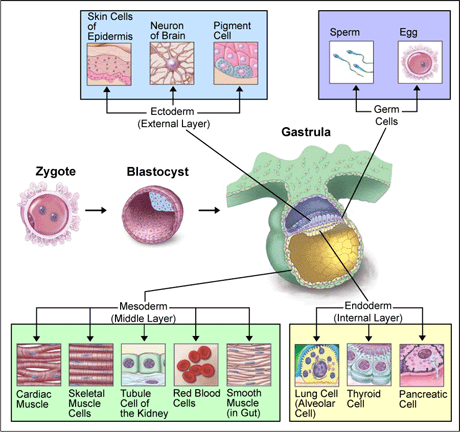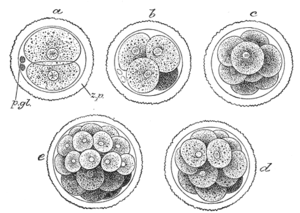Embryogenesis
Editor-In-Chief: C. Michael Gibson, M.S., M.D. [1]

Embryogenesis is the process by which the embryo is formed and develops. It starts with the fertilization of the ovum, egg, which, after fertilization, is then called a zygote. The zygote undergoes rapid mitotic divisions, the formation of two exact genetic replicates of the original cell, with no significant growth (a process known as cleavage) and cellular differentiation, leading to development of an embryo. It occurs in both animal and plant development, but this article addresses the common features among different animals.
The zygote
The egg cell (and hence the fertilized egg) is always asymmetric, having an "animal pole" (future ectoderm and mesoderm), two of three primitive tissue types, and a "vegetal pole" (future endoderm), it is also covered with different protective envelopes. The first envelope, the one which is in contact with the membrane of the egg, is made of glycoproteins and is called vitelline membrane (zona pellucida in mammals). Different taxa show different cellular and acellular envelopes.
Cleavage

The zygote undergoes rapid cell divisions with no significant growth, producing a cluster of cells that is the same size as the original zygote. The different cells derived from cleavage, up to the blastula stage, are called blastomeres. Depending mostly on the amount of yolk in the egg, the cleavage can be holoblastic (total) or meroblastic (partial)[2].
Holoblastic cleavage occurs in animals with little yolk in their eggs, such as humans and other mammals who receive nourishment as embryos from the mother, via placenta or milk. On the other hand, meroblastic cleavage occurs in animals whose eggs have more yolk; i.e. birds and reptiles. Because cleavage is impeded in the vegetal pole, there is a very uneven distribution and size of cells, being more and bigger at the animal pole of the zygote[3].
In holoblastic eggs the first cleavage always occurs along the vegetal-animal axis of the egg, the second cleavage is perpendicular to the first. From here the spatial arrangement of blastomeres can follow various patterns, due to different planes of cleavage, in various organisms:
| Holoblastic | Meroblastic |
|---|---|
|
Blastula and Gastrula
After the cleavage has produced over 100 cells, the embryo is called a blastula[4]. The blastula is usually a spherical layer of cells (the blastoderm) surrounding a fluid-filled or yolk-filled cavity (the blastocoel).
Mammals at this stage form a structure called the blastocyst[5], characterized by an inner cell mass that is not present in the blastula. The blastocyst must not be confused with the blastula; even though they are similar in structure their cells have different fates.
During gastrulation cells migrate to the interior of the blastula, consequently forming two (in diploblastic animals) or three (triploblastic) germ layers. The embryo during this process is called a gastrula. The germ layers are referred to as the ectoderm, mesoderm and endoderm. In diploblastic animals only the ectoderm and the endoderm are present [6].
- Among the different animals, different combinations of the following processes occur to place the cells in the interior of the embryo:
- Epiboly - expansion of one cell sheet over other cells[7]
- Ingression - cells move with pseudopods[8]
- Invagination - forming the mouth, anus, and archenteron[9]
- Delamination - the external cells divide, leaving the daughter cells in the cavity[10]
- Polar proliferation
- Other major changes during gastrulation:
- Heavy RNA transcription using embryonic genes; up to this point the RNAs used were maternal (stored in the unfertilized egg).
- Cells start major differentiation processes, losing their pluripotentiality.
In most animals a blastopore is formed at the point where cells are entering the embryo. Two major groups of animals can be distinguished according to the blastopore's fate. In deuterostomes the anus forms from the blastopore, while in protostomes it develops into the mouth.
Organogenesis
At some point after the different germ layers are defined, organogenesis begins. The first stage in vertebrates is called neurulation, where the neural plate folds forming the neural tube[11]. Other common organs or structures which arise at this time include the heart and somites, but from now on embryogenesis follows no common pattern among the different taxa of the animal kingdom.
In most animals organogenesis along with morphogenesis will result in a larva. The hatching of the larva, which must then undergo metamorphosis, marks the end of embryonic development.
See also
External links
Reference
- ^ What is a cell? 2004. A Science Primer: A Basic Introduction to the Science Underlying NCBI Resources. NCBI.
- ^ Campbell, Neil A.; Reece, Jane B.; Biology Benjamin Cummings, Pearson Education Inc 2002.
de:Embryogenese et:Embrüogenees eu:Enbriogenesi Template:Jb1